The Red Rainbow Socks is the second post in the Rainbow Sock Collection Series. It follows the first post ‘What is the Perfect Basic Sock Pattern?‘.
The Rainbow Sock Collection Series came about after my search during the summer for the perfect basic sock pattern. I wanted a sock that fitted my foot snugly and was comfortable to wear.
I chose Lang Jawoll Magic in Red Stripes and knew that I wanted the self striping yarn to repeat evenly from cuff to toe so that there was no break in the pattern when the heel was being knit.
It was also important to me that the finished sock would look elegant.
Design Choices
- Will the heel and toe work well with the chosen sock yarn?
- Will there be a good ‘balance’ between the cuff, heel and toe?
Balance became the main design concept for these socks.
These design choices immediately pointed towards one of the afterthought methods for the heel.
I like the Paired Decrease Toe. I’ve always found it comfortable to wear and easy to knit and had wondered how it would work as a heel.
So many toes and heels seem to be relatively interchangeable. As this style of toe and heel have a neat ‘4 stitch band’ between the upper and lower decrease stitches, I knew I wanted the cuff style to accentuate this.
I knit a rolled edge after casting on followed by a knit 2 purl 2 rib. The rolled edge was balanced by finishing the cuff with purl rows after the rib.
The self striping Lang Jawoll Magic is an amazing yarn to knit with. I chose colour 84.0065 which is a wonderful range of reds from tones of magenta to ruby red and scarlet. Personally, I love the halo of the knit fabric that is produced. It is a warm comfortable sock. An excellent sock yarn blend of 75% superwash new wool with 25% nylon for the ultimate strength and longevity of the finished socks.
Red Rainbow Sock Pattern
Please note that the Red Rainbow Sock Pattern is a one size free pattern. However, I do explain how you can work out how many rows you need to knit to have the socks the correct length for your foot.
The sock is knit from the cuff down.
Yarn
- 1 ball Lang Jawoll Magic Superwash Colour 84.0065
Needles
- 1 set of five 2.75mm double pointed needles (dpns) for knitting sock.
- I use one 3.5mm double pointed needle for casting on.
Gauge
The gauge for this sock is 20 rows and 16 stitches / 5cm (2 inch) square in stocking stitch (stockinette). 8 stitches / 2.5cm (1 inch).
Abbreviations
double pointed needle(s) – dpn(s); stitch(es) – st(s); knit – k; purl – p; knit 2 stitches together – k2tog; slip, slip, knit – ssk;
Cuff
- Cast on 60 stitches using the 3.5mm dpn.
- Then evenly divide the stitches onto four 2.75mm dpns. Take care not to twist the stitches when knitting the first round. There are 15 stitches on each needle.
Rolled edge
- Knit 14 rounds to create the rolled edge.
Ribbed cuff
- Work 16 rounds of k2, p2 rib.
- Followed by 5 rounds of purl.
Leg
- Knit 45 rounds or you can add more rounds if you would like the sock leg to be longer.
- This is the point where you would normally start knitting the heel. A heel uses half of the total stitches – 30 stitches.
Afterthought heel Set Up
This sock has an afterthought heel. Use a length of contrast yarn (about a metre). I chose ivory yarn as a strong contrast to the deep red of these socks. It helps to use a smooth yarn as it is then easier to remove later when you\’re doing the afterthought heel.
Knit the 30 heel stitches using the waste yarn. Then continue knitting the foot of the sock with the red sock yarn (you’ll be knitting across the waste yarn stitches first).
One of the problems with an afterthought heel is knowing how long to knit the foot before starting the toe. With this type of sock it isn’t possible to try on the sock for fit until you have finished the sock. Therefore, it becomes necessary to think about how many rows will be needed for knitting the foot and having some negative ease. A sock should be a bit smaller than your actual foot. This helps prevent the sock from moving around on your foot. I don’t use as much as 10%. But many sock knitters use anything between 10-15% negative ease for their socks. It is very much a matter of your own preference.
Length of the Foot and Negative Ease
To make sure that the sock will fit your foot, it helps to either measure your foot (the better option), or you can refer to a foot size chart. The Zappos ‘Measure Your Shoe Size‘ is helpful as it covers US, European and UK sizes.
Taking my foot as an example:
Metric Version
My foot measures 25cm. I don’t like as much as 10% negative ease in the length as my toes don’t like to be too restricted. So I subtract 1.25cm in length but if you prefer 10% you would subtract 2.5cm. This toe and heel will measure approximately 10cm.
- 25cm – 1.25cm = 23.75cm – 10cm = 13.75cm
Therefore, I will knit the foot until it measures 13.75cm from the ivory waste yarn. Then I will start knitting my toe.
Imperial Version
My foot measures 9 3/4 inches. I subtract 1/2 inch for negative ease. This toe and heel will measure approximately 4 inches.
- 9 3/4″ – 1/2″ = 9 1/4″ – 4″ = 5 1/4″
So I should knit the foot until it measures 5 1/4 inches from the ivory waste yarn. Then I will start knitting my toe.
If you know the length of your foot, you will be able to work out how long you should knit the foot of the sock, so that it will be the correct size for you.
How the Heel Fits
The other problem I have had with afterthought heels is the actual fit of the heel on my heel. The first afterthought heels that I made felt too shallow and flat in the heel instead of fitting my heel snugly. This also caused the instep to be too stretched across arch of my foot.
I decided to add additional rounds to the heel so that there is a bit more ‘space’ in the heel. It should stop the stretching of the instep when I wear the sock.
Knitting the foot
- Knit 55 rounds. The gauge is 4 rows / cm x 13.75cm = 55 rounds.
- You may prefer to just measure. I have a habit of counting rows so that both of my socks will be exactly the same size.
Basic Paired Decrease Toe
- Each round starts and ends at the centre point of the sock’s sole.
- The decrease round: For Needle 1 and Needle 3: knit to the last 3 sts, k2tog, k1; For Needle 2 and Needle 4: k1, ssk, knit to the end of the needle.
The decrease round creates the shaping in the toe for a comfortable neat fit.
- Round 1: work decrease round
- Rounds 2-4: k
- Round 5: work decrease round
- Round 6-7: k
- Repeat rounds 5-7 once more
- Round 11: work decrease round
- Round 12: k
- Repeat rounds 11 & 12 two more times.
- Work the decrease round for remaining 6 rounds until there are two stitches remaining on each needle. Slip the stitches from needle 2 onto needle 1. Slip the stitches from needle 4 onto needle 3
- Graft the toe.
The Afterthought Heel
There is an excellent tutorial on how to do the Afterthought Heel on the Knitting Up A Storm blog. Part 1: the set up – shows how to add the waste yarn. Part 2: Releasing the ‘live stitches’ – clearly shows how to pick up the live stitches for knitting the afterthought heel.
You will have 15 stitches on each of the four needles.
- Once the live stitches are on the needles, knit 2 rounds.
- Then follow my heel instructions.
The decrease round is worked in the same way as for the toe.
- Round 1: work decrease round
- Rounds 2-4: k
- Repeat rounds 1 to 4 twice more
- Round 13: work decrease round
- Round 14-15: k
- Repeat rounds 13 to 15 once more.
- Work the decrease round for remaining rounds until there are two stitches remaining on each needle. Slip the stitches from needle 2 onto needle 1. Slip the stitches from needle 4 onto needle 3
- Graft the heel.
Finished the Red Rainbow Socks
With these socks, I washed and blocked them before wearing them. One thing I did notice after the sock was finished before it was washed was that the ‘4 stitch band’ sat a little proud of the heel shaping. This completely disappeared after the socks had been washed and blocked the first time. Once the socks have been worn and washed several times the heel shaping is completely smooth because the final 8 stitches are grafted together giving a smooth finish to the heel.
Enjoy wearing your new pair of socks. Let me know what you think of your socks in the comments below.
Related Rainbow Sock Collection Links
The photographs were taken at Fallowvee near Waterfoot in Co Antrim, Northern Ireland.

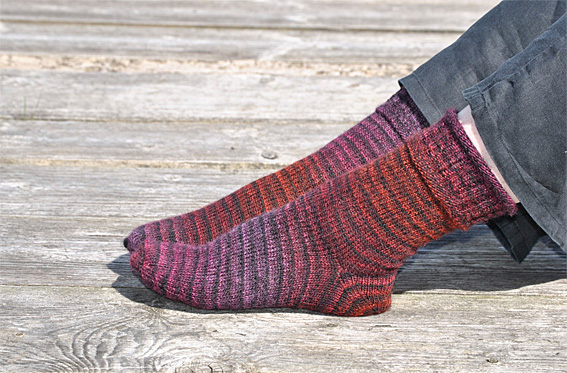
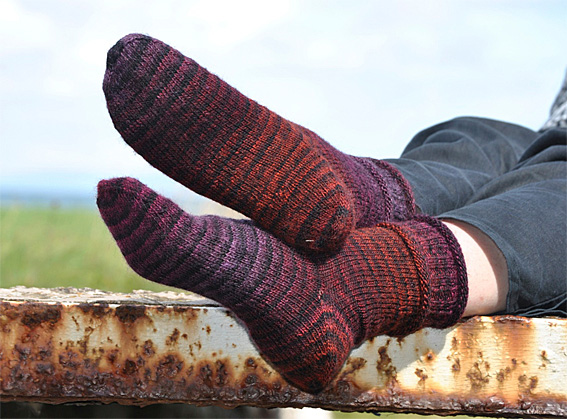
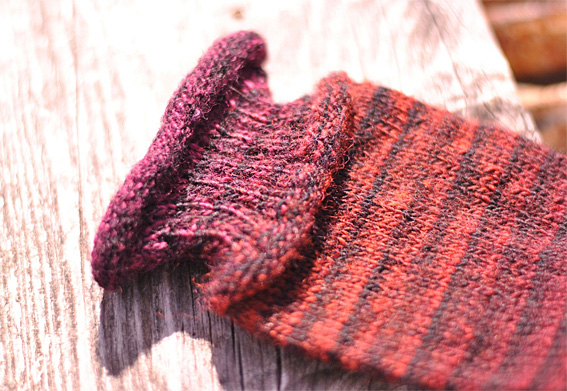
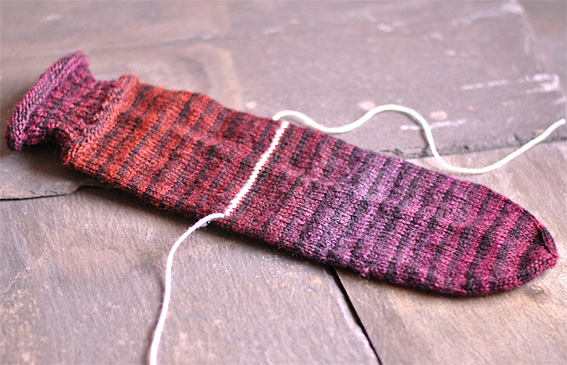
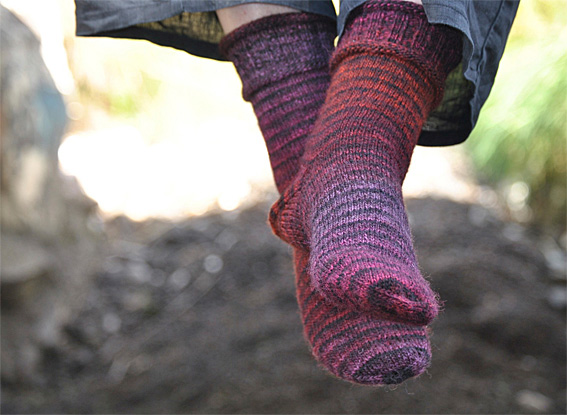
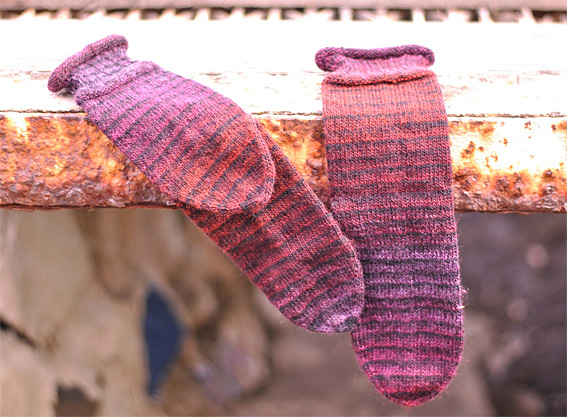
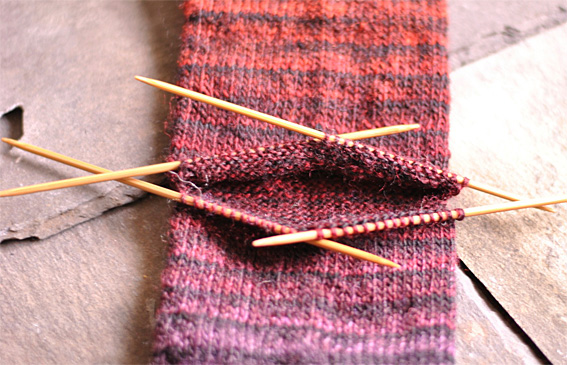
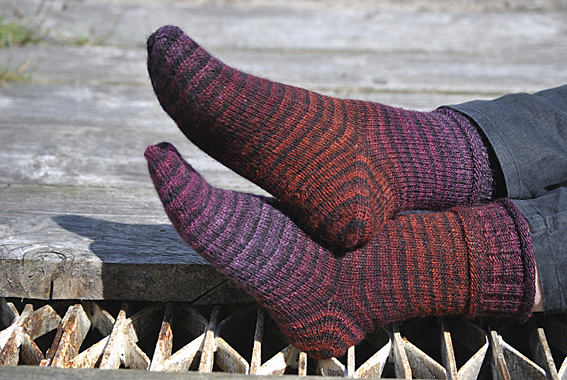
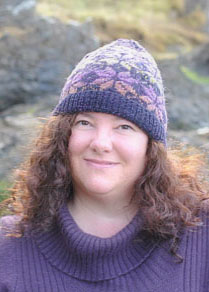
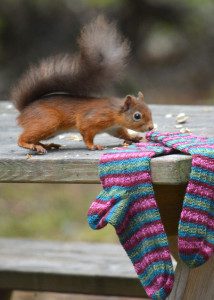
I am very grateful this post is still here for new sock knitters to learn from. Thank you very much for sharing this and the other posts, too!